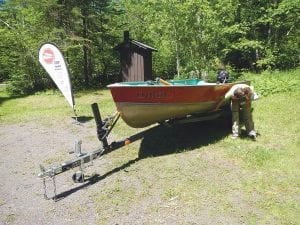Summer in Cook County means a lot of things and most of those things revolve around lakes and rivers. A new experience this summer might be that you are greeted by a smiling face at the landing. These faces belong to watercraft inspectors whose purpose is to educate the public to the threats of harmful aquatic invasive species (AIS).
Invasive species are defined as an organism that is not native and causes ecological or economic harm. Once established AIS change the water and fishing quality in lakes and rivers. Infestations in Cook County will put a large dent in the economy, which relies heavily on water recreation and tourism. One threatening aquatic invasive to our waters is the spiny water flea. These small crustaceans can be easily transported on fishing gear and anchor rope.
The good news is that 95 percent of the lakes and rivers in Minnesota are not infested with AIS.
Watercraft inspectors are ensuring boaters are following the AIS laws to protect the precious waters in Cook County. The simple AIS laws are Clean, Drain, Dispose: . Clean all plants and prohibited invasive species from watercraft, trailers, and gear . Drain water from all equipment and keep drain plugs out during transport . Dispose of unwanted bait in the trash, not in the water
Inspectors are focusing on educating recreationists how to clean their watercraft, the importance of draining, and how to properly transport or dispose of bait. This program aims to create new behaviors of watercraft users by checking for AIS every time they enter and exit a waterbody.
There are two types of inspections: Entering and Exiting. When a boat is entering the inspector will approach the boater and ask if they can do a quick inspection. The inspector looks and feels for any kind of water, mud, or plants. The inspector then asks the boater where the boat last launched, how long the boat has been out of the water, and where they plan on launching next. This inspection process can be done in less than three minutes. The exiting process is almost identical except the inspector wants to see the boater do his or her own inspection for aquatic invasive species.
Starting this boating season anyone violating the AIS laws will be required to complete a training before they can legally operate watercraft (along with paying the required fine). This training is also available to anyone interested in learning how to protect Minnesota’s waters.
The clean in, clean out training is short, free, and easily taken online at: www.dnr.state.mn.us/CICOtraining/index.html.
Overall, most Cook County residents and visitors are in compliance with the AIS laws. The few individuals that violate these laws are the highest risk factor for infesting a waterbody. The watercraft inspector program and the clean in, clean out training are designed to help people avoid a citation, but more importantly, to keep our lakes off the infested waters list.
Anyone with questions about the watercraft inspection process or other comments should email cookcountyais@gmail.com
Enjoy the water and remember: Spread the word, not the species.



Leave a Reply